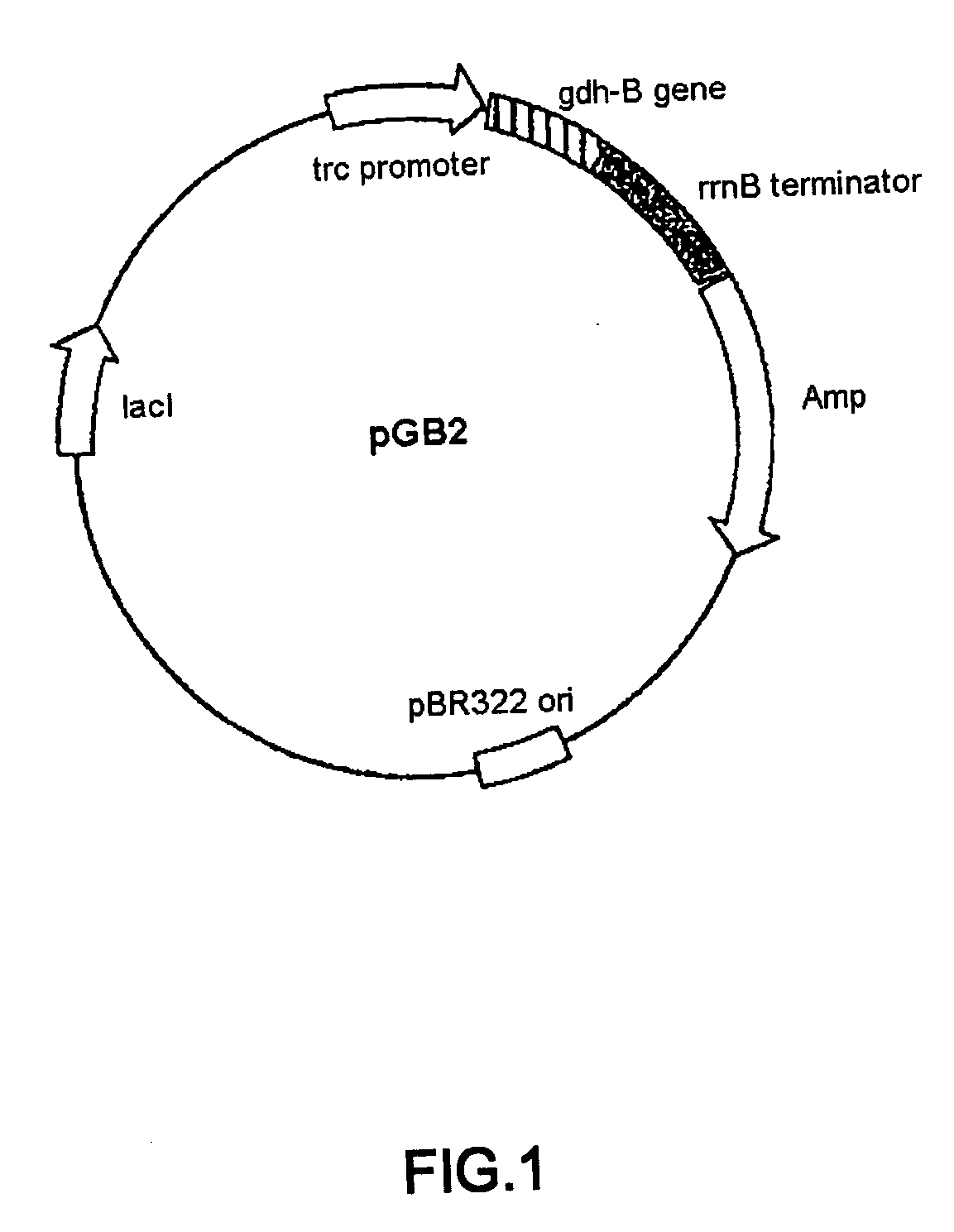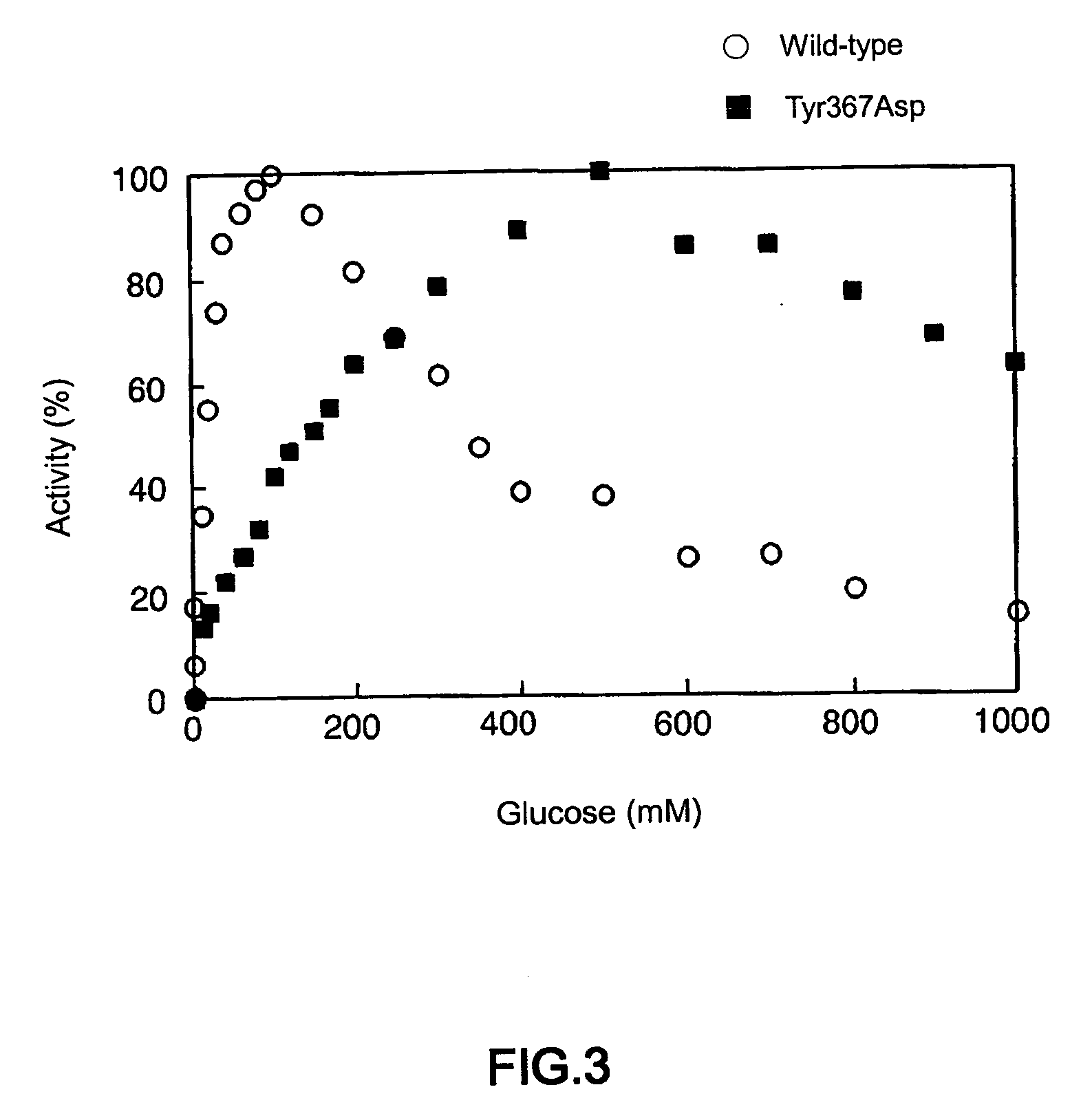Glucose dehydrogenase
a glucose dehydrogenase and glucose technology, applied in the field of modified glucose dehydrogenase, can solve the problem of difficult quantitative measurement of substrate concentration under high substrate concentration, and achieve the effect of low substrate inhibition level
- Summary
- Abstract
- Description
- Claims
- Application Information
AI Technical Summary
Problems solved by technology
Method used
Image
Examples
example 1
Construction of Gene Encoding Modified PQQGDH Enzyme
[0039] Mutagenesis was carried out based on the structural gene of PQQGDH derived from Acinetobacter calcoaceticus (SEQ ID NO:2). pGB2 plasmid was constructed by inserting the structural gene of PQQGDH derived from Acinetobacter calcoaceticus into the multi-cloning site of pTrc99A vector (Pharmacia) (FIG. 1). Wild type gene sequence encoding PQQGDH was replaced with altered gene sequence encoding modified PQQGDH by standard method as previously described. Site specific mutagenesis was performed using the pGB2 plasmid as shown in FIG. 2. The sequences of synthetic oligonucleotides used for mutagenesis are shown below. In order to construct a mutant containing two mutations, two oligonucleotide primers were used simultaneously for mutagenesis.
Met365Trp3′-GT TGA ACA CCT CTC CCA TGG ATG TAA AC-5′Met365Phe3′-GT TGA ACA CCT CTC CCT TGG ATG TAA AC-5′Thr366Asn3′-GGT TGA ACA CCT CTC TAC TTG ATG TAA ACG AC-5′Thr366Ile3′-GGT TGA ACA CCT C...
example 2
Preparation of Modified Enzyme
[0042] A Gene encoding wild type or modified PQQGDH was inserted into the multi-cloning site of pTrc99A (Pharmacia), and the constructed plasmid was transformed into E. coli DH5α. Transformants were cultured in 450 ml of L-broth using a Sakaguchi flask at 37° C. with vigorous shaking, and then inoculated in 7 L of L-broth containing 1 mM CaCl2 and 500 μM PQQ. After three hours of cultivation, IPTG was added to a final concentration of 0.3 mM, and cultivation was continued for another 1.5 hours. The culture medium was centrifuged (5000 xg, 10 min, 4° C.), and the pellet was washed with 0.85% NaCl twice. The cells were resuspended in 10 mM phosphate buffer (pH7.0), crushed with French press (110 MPa), and centrifuged twice to remove the debris. The supernatant was ultracentrifuged (40,000 rpm, 90 min, 4° C.), and the supernatant was collected as a water-soluble fraction. This fraction was dialyzed against A buffer (10 mM MOPS-NaCl buffer (pH 7.0)) at 4°...
example 3
Measurement of Enzyme Activity
[0043] Enzyme activity was measured in MOPS-NaOH buffer (pH7.0) containing PMS (phenazine methosulfate)-DCIP (2, 6-dichlorophenolindophenol). Changes in absorbance of DCIP was recorded with a spectrophotometer at 600 nm, and the reduction rate of absorbance was defined as the reaction rate of the enzyme. In this measurement, enzyme activity which reduced 1 μmol of DCIP in one minute was regarded as 1 unit. The molar absorption coefficient of DCIP at pH 7.0 was 16.3 M−1.
PUM
| Property | Measurement | Unit |
|---|---|---|
| molecular weight | aaaaa | aaaaa |
| pH | aaaaa | aaaaa |
| flow rate | aaaaa | aaaaa |
Abstract
Description
Claims
Application Information
 Login to View More
Login to View More - R&D
- Intellectual Property
- Life Sciences
- Materials
- Tech Scout
- Unparalleled Data Quality
- Higher Quality Content
- 60% Fewer Hallucinations
Browse by: Latest US Patents, China's latest patents, Technical Efficacy Thesaurus, Application Domain, Technology Topic, Popular Technical Reports.
© 2025 PatSnap. All rights reserved.Legal|Privacy policy|Modern Slavery Act Transparency Statement|Sitemap|About US| Contact US: help@patsnap.com



